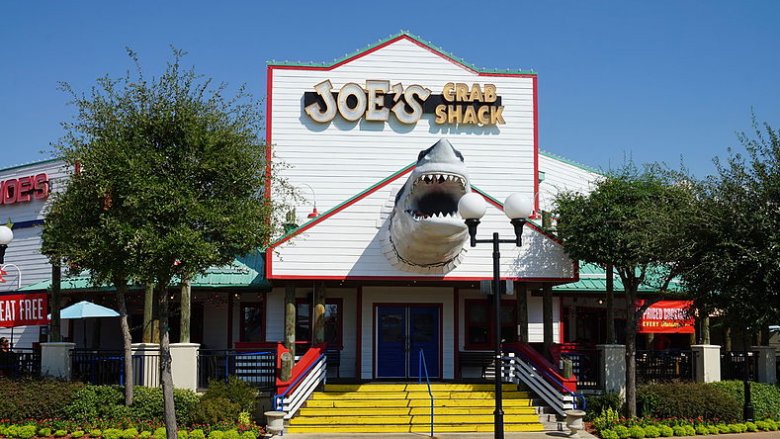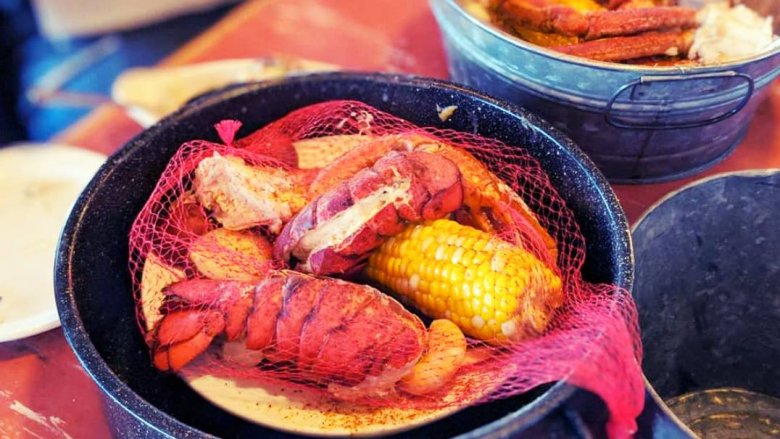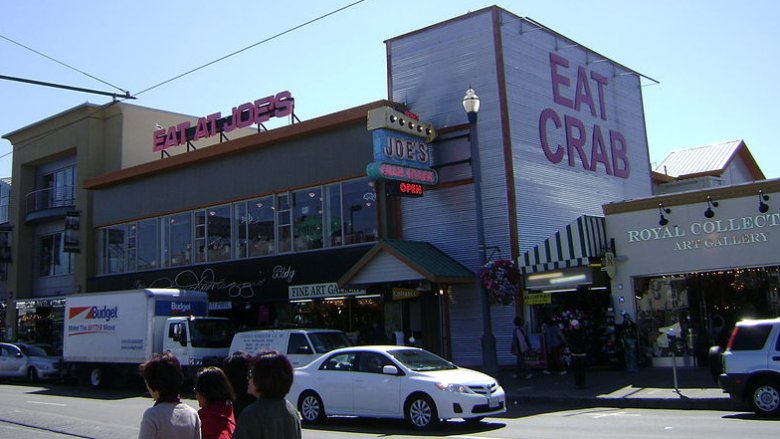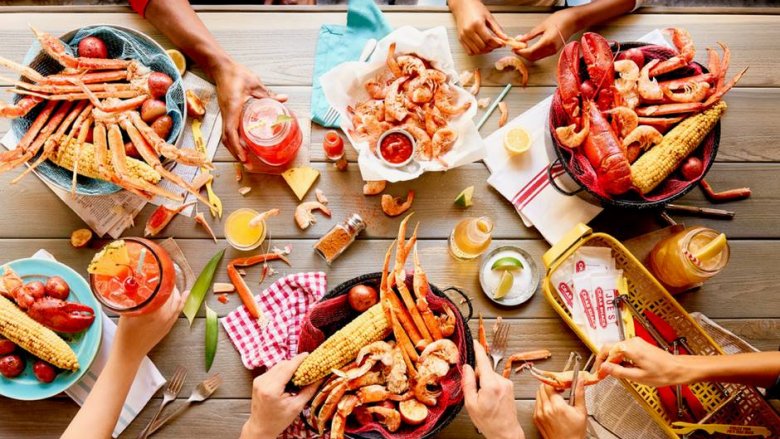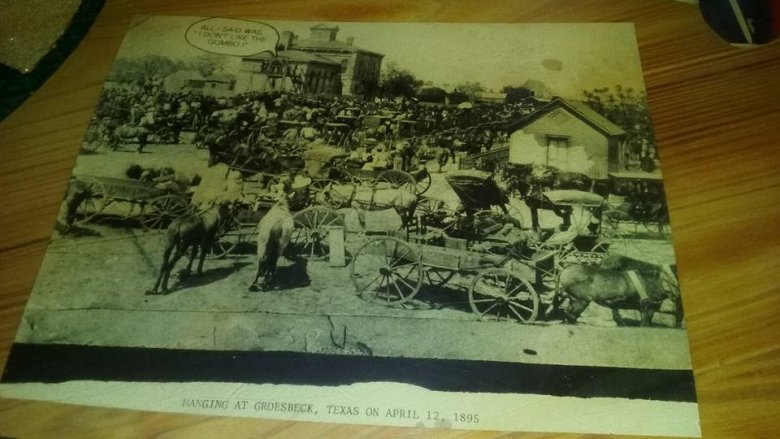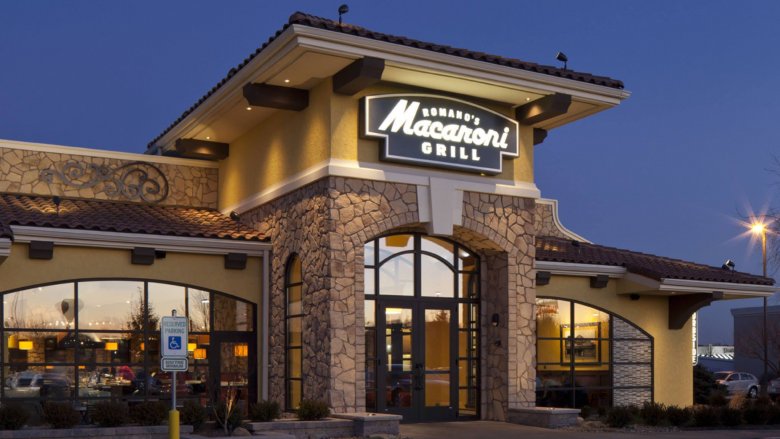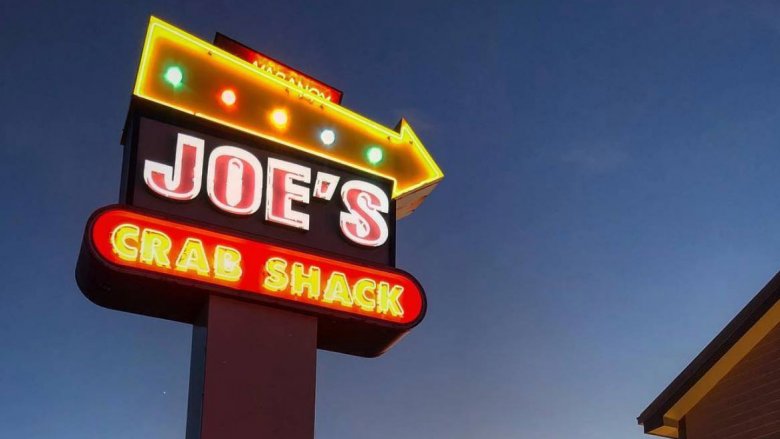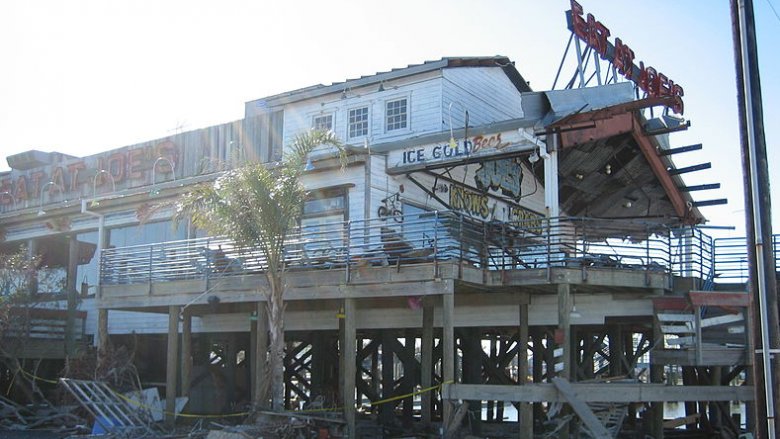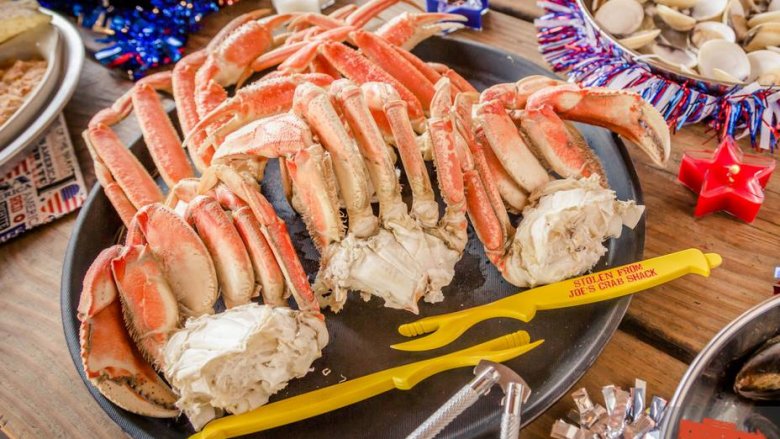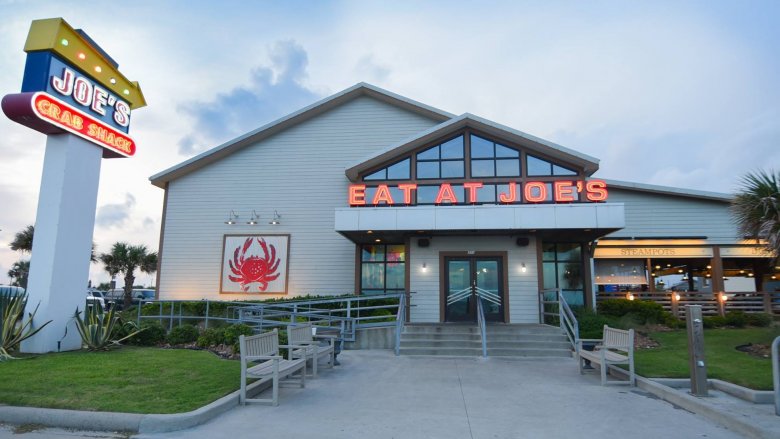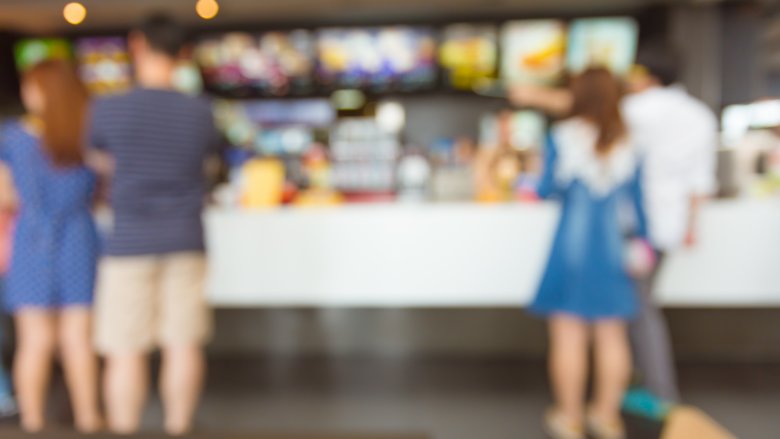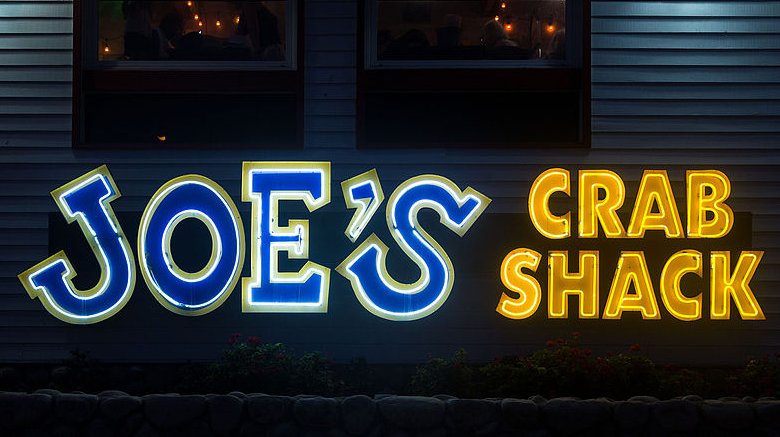The Real Reason Why Joe's Crab Shack Is Disappearing Across The Country
If you constantly find yourself craving a vat of snow crab with a side of coconut shrimp (and permission to wear a bib as a grown adult), you might not be able to get your fix at your local Joe's Crab Shack much longer. There were almost 140 Joe's spots available for your dining and crab cracking pleasure in 2014. Today, the Joe's Crab Shack website reveals there are only 57 locations still operating. In 2016, the chain reported an operating loss of $16.6 million.
The first Joe's Crab Shack opened in Houston, Texas in 1991. As the brand grew and started franchising, it became pretty popular into the early 2000s. While locals in coastal towns might consider Joe's Crab Shack a tourist trap, they can't disagree that it delivers a wide variety of seafood items in a fun, family-oriented atmosphere.
So why are the shacks getting the shaft? Here are some possible explanations for why Americans aren't taking the bait on all you can eat shrimp specials at Joe's Crab Shack anymore.
They said they'd stop using trans fats... but didn't
Cheap, easy, and resilient, trans fats are a no-brainer for restaurants trying to cut costs or food manufacturers looking to extend their product's shelf life. But trans fats can be disastrous for your health. So when Joe's Crab Shack vowed to stop cooking with trans fat in 2007, but got busted seven years later for continuing to use the stuff, health experts threw shade. What's even more alarming is that it continued to use trans fats in menu items that could be made with real butter, since that's what they did at locations in the cites, counties, and states that had banned the use of artificial trans fat.
According to Consumerist, the Center for Science in the Public Interest (CSPI) called out Joe's Crab Shack in 2014 for serving up dishes chock full of trans-fat laden margarine, namely in the "Joe's Pasta-laya," crab cake dinner and steam pots. The executive director of CSPI, Michael F. Jacobson, warned consumers, "Until the company fixes the problem and switches to a healthier substitute, eat at Joe's at your own risk—an increased risk of heart disease and premature death."
As more Americans learn about the impact the foods they consume have on their overall health, it's possible these headlines were part of what deterred customers from continuing to eat at Joe's Crab Shack. That could have certainly contributed to declining sales for the chain.
Some employees sued for labor law violations
It's never a good sign when your staff is so unhappy, they get the US legal system involved. But that's exactly what happened at a Joe's Crab Shack location in San Francisco in 2014, when nine very disgruntled former Joe's Crab Shack workers sued the chain for not abiding by labor laws.
Among the claims from the back of the house employees were accusations that the management at this Joe's refused to grant proper breaks, manipulated the record of their hours to avoid paying overtime, and didn't reimburse them for the cost of uniforms. What's even more alarming, allegedly, some of the workers were terminated when they tried to voice their concern about the labor law violations.
The saying has always been that any press is good press... that's not necessarily the case when it's the kind of press where your employees publicly shame you for treating them poorly. This unfortunate PR might not have sat well with folks who were deciding what seafood chain to choose for a night out, making it another possible factor in Joe's demise.
Their no-tipping strategy was a massive failure
In an effort to boost morale, retain more employees, and pay the front-house staff more, Joe's Crab Shack started experimenting with a no-tip policy in the summer of 2015. The staff's hourly pay went up, and so did the menu prices — items were costing 12 to 15 percent more. They instigated the no-gratuity-necessary test at 18 restaurants. Joe's employees and customers seemed to dig it... until they didn't.
In May of 2016, the restaurant announced it would reinstate tipping. Apparently, the clientele at the no-tip locations spoke with their wallet. While then-CEO of Joe's then-parent company Ignite Restaurant Group, Bob Merritt, said he would keep the policy at four of the restaurants, the amount of diners at the no-tipping outposts declined eight to 10 percent. A customer survey revealed that 60 percent of Joe's patrons felt like the promise of a tip was incentive for great service. Patrons also indicated that they didn't trust The Man (who, in this instance, is the upper level management at Joe's Crab Shack) to fairly compensate servers. One might argue that the entire experiment left a permanent bad taste in customer's mouths — one that couldn't be alleviated with even the tastiest of steamed seafood.
They used a racially insensitive photo as table decor
For years it wasn't uncommon for family-style casual dining chain restaurants to display a bunch of random, obscure paraphernalia. But now they're making a massive effort to declutter in hopes of capturing the appeal of the simpler aesthetics of fast casual chains. Perhaps the revamps are also necessary because while historical prints and knick-knacks on the walls and tables might have the intention of evoking nostalgia, they also open the potential for something seriously offensive to slip through the cracks.
In March of 2016, at a Joe's Crab Shack in Roseville, Minnesota, two patrons discovered a photo embedded into the table that depicted a group of white people witnessing the lynching of an African American man. The title was "Hanging at Groesbeck, Texas, on April 12th, 1895." A line at the top was a 'joke' caption that read, "All I said was that I didn't like the gumbo." The African American couple who'd sat at the table were understandably very upset and the Minneapolis NAACP demanded Joe's corporate office issue an apology. The restaurant immediately removed the photo and showed much remorse, but it's still disturbing someone had approved that decor in the first place. When the story broke, others reported seeing the same photo at other Joe's locations. Maybe this bad press was part of why Joe's Crab Shack really took a downward turn the following year.
Buying Macaroni Grill may have been a huge mistake
Joe's Crab Shack's parent company at the time, Ignite Restaurant Group, borrowed a lot of funds and spent $55 million to snatch up Macaroni Grill in 2013. The purchase included over 200 restaurants in the U.S. and overseas. But just as it bought the chain, the trend toward fast casual dining really started to take off and its clientele began to wane. Ignite Restaurant Group ultimately ended up selling Macaroni Grill just two years later (at a major loss) for $7.3 million.
And it never really recovered. In March of 2017 Ignite Restaurant Group Inc. got the boot from the Nasdaq Stock Exchange and was delisted. Just two months later, in May of 2017 Ignite reported quarter drops in performance at Joe's Crab Shack and the other chain it owned, Brick House Tavern, with a 14.3 percent and 12.6 percent decline in same-store sales, respectively. It announced it was looking for a buyer at that time and considering bankruptcy protection. In their Securities and Exchange Commission filings, the company said, "The sales declines are primarily due to decreased guest traffic... We have deployed many different operational strategies, but so far none have had a meaningful impact on sales or guest traffic." Finally, in June of 2017, Ignite Restaurant Group, filed for bankruptcy, citing debt of $197 million and assets of only $153 million. Ignite's revenue had decreased 8.5 percent between 2015 and 2016.
According to Jon Berke, middle markets editor for Debtwire (via Houston Chronicle), the purchase of Macaroni Grill was really the beginning of the end for Ignite and Joe's Crab Shack. "Honestly, it seems to me the first sign of real trouble was when Macaroni Grill became part of the company," he said.
Its previous owner bought it and immediately downsized
About two months after Ignite Restaurant Group filed for bankruptcy, in a true circle of (sea) life moment, Joe's Crab Shack's previous owner from 1994 to 2006, Landry's, Inc., won the August 17, 2017 bankruptcy court case following auction where Landry's had been the highest bidder. It acquired Ignite with a bid of $57 million.
Right away Landry's CEO Tilman Fertitta said it would likely reduce the number of Joe's Crab Shack to just 60 locations. Fertitta also discussed potentially transforming some of the under-performing Joe's Crab Shacks into concepts already under the Landry's umbrella. Some of Landry's most popular establishments include Rainforest Cafe, Bubba Gump Shrimp, and Morton's Grille.
While Ignite was struggling to dig themselves out of a hole, Landry's thrived despite changes in American dining trends, with revenue increasing by $100 million from 2015 to 2017. Armed with the success of a booming business, Fertitta maintained Landry's could salvage the Joe's brand, but so far that hasn't proven to be the case.
Its waves of abrupt restaurant closures didn't sit well with anyone
Even before Joe's Crab Shack had been shifted back to its previous owners, their rep had suffered when locations in New Jersey, Virginia, Nebraska and New York abruptly ghosted loyal consumers and several employees with sudden closures. It's possible the closings that happened prior to the official sale to Landry's were a result of landlords ending leases because of the bankruptcy proceedings — something that would be pretty out of Joe's hands. (Although some say the Monmouth, New Jersey location closed because it couldn't compete with nearby Red Lobster.) The NJ location closed in July of 2017 while the others shut down in the first week of August, just before the final bankruptcy auction.
Then when the Landry's, Inc. purchase became official, the closing didn't stop — over 40 more restaurants suddenly shut down later that same August. In nearly all of these closures, many employees were left confused and stressed at the unexpected reality of staring down the barrel of job applications after reporting to work and finding their restaurants closed. The higher ups didn't warn or notify anyone via email or phone, and apparently there were even customers who showed up with group reservations. Needless to say, Joe's could not honor their bookings.
It's possible that disgruntled former employees and customers swore off the chain when this all went down or even told their social circles. That easily could have lost Joe's Crab Shack some clout and patrons, even as Landry's tried to salvage its name after bankruptcy.
It's not transparent about where it sources its seafood from (but it's likely not local)
If you do a deep dive into the Joe's Crab Shack website, you won't find much intel on where they get their namesake product. But a report from PBS News reveals that 90 percent of the seafood Americans eat is from international sources. Interestingly enough, according to Brian Mader, owner of Marder Trawling in Cape Cod, Massachusetts, most of what the fishermen catch in his area is exported to Europe. Regardless, it's a safe bet that Joe's isn't getting fresh crab from the guys who star on Discovery's Deadliest Catch. In fact, 75 percent of the king crab we eat in the U.S., we got from Russia.
This could all continue to affect the survival of Joe's Crab Shack, if they don't make a consistent (and perhaps vocal) effort to source seafood locally — or at least domestically. As more Americans recognize the importance of sourcing and buying local, it's more likely they'll opt for seafood restaurants that are transparent about how they source their food. It helps fishermen who need local markets to improve their bottom lines, and maintain sustainable communities on the coasts. The lack of transparency around they're food (and what they use to cook their food) could have been a contributor to less enthusiasm for the restaurant and, in turn, its overall decline.
American families are choosing to eat at home more often
Why eat at Joe's when you can eat at home, with Netflix and a meal kit? In an effort to save money and eat healthier, folks across the country are opting to cook at home rather than go out to eat. According to Bloomberg, the average American dined in restaurants around 216 times in the year 2000. By 2017, that number dropped to 185. Eating at home is more convenient than ever with pre-chopped veggies and pre-washed lettuce in the produce section, or meal kit services that deliver the exact amount of ingredients you need directly to your door. Meal kits generated $5 billion in revenue across the globe in 2015.
To try to counteract the "down with eating out" trend, some restaurants are experimenting with their own meal kits. Several Chick-fil-A restaurants in Atlanta are offering meal kits that people can pick up then take home to prepare. But since a big part of the allure of Joe's Crab Shack is the ability to messily crack and eat crab at the table, it seems implausible that this would ever be an option for them. The popularity of meal kits and efforts to save money by eating at home have no doubt caused Joe's Crab Shack traffic to suffer.
When they do eat out, Americans prefer fast food
While casual dining joints like Joe's Crab Shack are struggling to keep customers coming, fast food chains continue to kill it. Between 2013 and 2016, around 37 percent of adults got a fast food fix on a given day, according to the Centers for Disease Control and Prevention. Why would the average American diner opt for White Castle over Joe's Crab Shack? Fast food is cheap and filling — it offers plenty of calories to keep you full without putting a huge hole in your wallet.
It's also quicker. Oftentimes hungry people would rather zip through a drive-thru and commence eating from their vehicle as soon as that sack of food is in their hands, than settle into a booth to order from a menu and count the minutes until the food arrives. It's also possible that individuals often choose where to eat based on convenience, not cravings. And it's hard to foresee a world where we'd want crab served out of a drive-thru window, even if it was available. Joe's Crab Shack isn't just a quick meal, it's an experience, and perhaps one that Americans have become less and less interested in having since its hey day at the turn of the century.
The Joe's Crab Shack blog has been abandoned
While blogging is somewhat of a lost art form thanks to the ever dwindling attention span of your average human, if you are going blog, you better do it consistently. As of this writing, the Joe's Crab Shack website blog hasn't been updated since January 3, 2018. That might as well be centuries in blog years, y'all. How's their #breakoutyourbib campaign going? Maybe we'd know if they updated the ole' blog every once in a while.
In the 21st century, maintaining an active presence on the internet is essential for a business to be successful. Blogging is good for business because it drives more internet users to company sites. Never underestimate the power of an online search engine. If people are Googling "best crab restaurants near me" or "best place to get a bucket of steamed crustaceans ASAP," and the Joe's Crab Shack's website blog isn't popping up in the search results, they are missing out on one of the smartest ways to get more people in their restaurants. So it could have hurt their numbers if people were instead going to the restaurants that did pop up when they searched.
